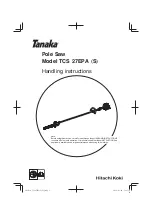
7
un bloque en “V” para soportar el material.
El material ondulado,
como por ejemplo las molduras, tenderá a oscilar y podría atorarse
mientras se realiza el corte. Las piezas redondas
tenderán a rodar mientras están siendo cortadas y la hoja podría
“penetrar y engancharse”, y arrancarlas del control del operador.
No retire las piezas de corte atoradas hasta que la hoja se
haya detenido. No toque nunca la hoja u otras piezas móviles
durante el uso.
El contacto con la hoja u otro mecanismo móvil
podría causar lesiones.
Use protección de los ojos y protección respiratoria. Sepa
como apagar la herramienta en una emergencia.
No exponga la herramienta a la lluvia ni la use en lugares
húmedos.
Se requiere conexión a tierra.
General power tool safety warnings
Warning!
Read all safety warnings and all instructions.
Failure to follow the warnings and instructions may result in
electric shock, fire and/or serious injury.
Save all warnings and instructions for future reference.
The term “power tool” in the warnings refers to your mains-operated
(corded) power tool or battery-operated (cordless) power tool.
1. Work area safety
a) Keep work area clean and well lit.
Cluttered or dark areas
invite accidents.
b) Do not operate power tools in explosive atmospheres,
such as in the presence of flammable liquids, gases or
dust.
Power tools create sparks which may ignite the dust or
fumes.
c) Keep children and bystanders away while operating a
power tool.
Distractions can cause you to lose control.
2. Electrical safety
a) Power tool plugs must match the outlet. Never modify the
plug in any way. Do not use any adapter plugs with earthed
(grounded) power tools.
Unmodified plugs and matching
outlets will reduce risk of electric shock.
b) Avoid body contact with earthed or grounded surfaces,
such as pipes, radiators, ranges and refrigerators.
There
is an increased risk of electric shock if your body is earthed or
grounded.
c) Do not expose power tools to rain or wet conditions.
Water entering a power tool will increase the risk of electric
shock.
d) Do not abuse the cord. Never use the cord for carrying,
pulling or unplugging the power tool. Keep cord away
from heat, oil, sharp edges or moving parts.
Damaged or
entangled cords increase the risk of electric shock.
e) When operating a power tool outdoors, use an exten-
sion cord suitable for outdoor use.
Use of a cord suitable
for outdoor use reduces the risk of electric shock.
f) If operating a power tool in a damp location is unavoid-
able, use a residual current device (RCD) protected
supply.
Use of an RCD reduces the risk of electric shock.
g) In case that it has necessity of substitution of the electric
handle must direct the tool for an assistance authorized
technique.
A damaged handle increase the risk of electric shock
3. Personal safety
a) Stay alert, watch what you are doing and use common
sense when operating a power tool. Do not use a power
tool while you are tired or under the influence of drugs,
alcohol or medication.
A moment of inattention while operat-
ing power tools may result in serious personal injury.
b) Use personal protective equipment. Always wear eye
protection.
Protective equipment such as dust mask, non-
skid safety shoes, hard hat, or hearing protection used for
appropriate conditions will reduce personal injuries.
c) Prevent unintentional starting. Ensure the switch is in
the off-position before connecting to power source and/
or battery pack, picking up or carrying the tool.
Carrying
power tools with your finger on the switch or energising
power tools that have the switch on invites accidents.
d)
Remove any adjusting key or wrench before turning the
power tool on.
A wrench or a key left attached to a rotating
part of the power tool may result in personal injury.
e)
Do not overreach. Keep proper footing and balance at
all times.
This enables better control of the power tool in
unexpected situations.
f)
Dress properly. Do not wear loose clothing or jewellery.
Keep your hair ans clothing away from moving parts. Loose
clothes, jewellery or long hair can be caught in moving parts.
g) If devices are provided for the connection of dust extrac-
tion and collection facilities, ensure these are connected
and properly used.
Use of dust collection can reduce dust-
related hazards.
2089_Manual_Skil_3335.indd 7
2089_Manual_Skil_3335.indd 7
10.02.10 14:19:37
10.02.10 14:19:37








































